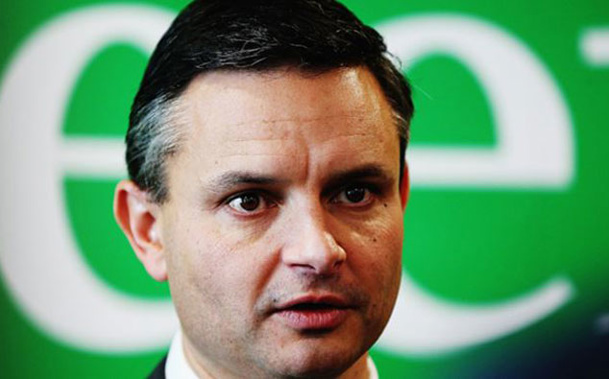
Climate Change Minister James Shaw will head to the COP26 conference in Glasgow with an ambitious new emissions reduction commitment: cutting net emissions to 50 per cent below gross 2005 levels by 2030.
Prime Minister Jacinda Ardern said the "enhanced contribution to the global effort to fight climate change now represents our fair share, and is in line with what's needed if we are to avoid the worst impacts of global warming on New Zealand".
The new target dramatically lifts New Zealand's existing emissions reduction committed, which was set as part of the Paris Agreement in 2015.
That 2015 target was to reduce emissions by an average of 30 percent from 2005 levels, over the 2021-2030 period.
That target used a different methodology however - an apples and apples comparison means the 30 per cent Paris target has now been lifted to a 41 per cent reduction target.
Emissions today are roughly the same as they were in 2005, so the target will mean significant cuts between now and the end of the decade.
The target is ambitious - so ambitious that from the outset, the Government has acknowledged New Zealand will need to help reduce other countries' emissions and count those reductions towards our target.
Two thirds of the emissions reductions are likely to come from offshore arrangements.
New Zealand is far from the only country to lift its initial Paris target.
When signing the Paris agreement, countries agreed to each set a Nationally Determined Contribution or NDC, which would be their own emissions reduction goal.
They agreed to review these each five years and try to make the emissions reductions more ambitious at each review.
Thanks to the Covid-19 pandemic postponing the Glasgow conference, COP26 is the first five-year review of those NDCs. Many countries have submitted revised NDCs this year - New Zealand is relatively slow to submit a its own revised target.
Cabinet agreed the new NDC on Monday after months of behind the scenes negotiations.
Shaw said the new commitment was consistent with the Paris goal of limiting global warming to 1.5˚C above pre-industrial levels, a goal which is now part of New Zealand's climate legislation.
Earlier this year, the Climate Change Commission published a review of the first NDC and found it to be inconsistent with the 1.5 degrees goal.
/cloudfront-ap-southeast-2.images.arcpublishing.com/nzme/RROUEGNWU7JUCHYNDD75PLQGSE.jpg)
Climate Change Minister James Shaw has unveiled a new Paris commitment for New Zealand. Photo /Mark Mitchell.
Shaw said this new target would bring our commitments in line with 1.5 degrees.
"Two years ago we put the 1.5˚C global warming limit into our Zero Carbon Act. Today we're upping our commitment to help keep the world on track to meeting it," Shaw said.
"I am confident we can do it and in doing so open the door to a thriving world that is cleaner, healthier, and more equitable," he said.
What about the cows?
Experts were happy the NDC had been revised, but were sceptical that the target could be reached.
Dr Lauren Vargo, research fellow at the Antarctic Research Centre at Victoria University said it was "good for a new target".
"This target is ambitious, but climate change is a threat to the economy, environment, and human lives," she said.
But she said she wondered how we will meet such an ambitious target in just nine years.
"This will take greater commitment, action, and innovation from industry and government".
Greenpeace was far more critical, saying the NDC was "dodgy".
Greenpeace Aotearoa agriculture campaigner Christine Rose said the target was unambitious and would leave New Zealand to "wimp out" of serious climate change by "opting for techno fixes and offshore options".
Shaw maintained the target was ambitious, and produced data to show the new NDC was comparable with the reductions targets of the European Union, and Japan, although it is well short of climate change leaders like the UK and Switzerland.
/cloudfront-ap-southeast-2.images.arcpublishing.com/nzme/COVTWASEIGEO6IPSZQTSPLAQOQ.jpg)
Climate activists marching through London earlier this year. Photo /AP-David Cliff
Rose said the NDC had no plan to address agricultural emissions.
"Agriculture is our biggest climate polluter but time after time, it has been given a free pass by this Government and successive governments before them.
"To reduce emissions we need to eliminate synthetic nitrogen fertiliser, and lower stock numbers," she said.
The place of agriculture in New Zealand's climate strategy has bedevilled politicians for decades.
Agriculture is the country's biggest-single emitter, but those emissions are mainly methane, a short-lived gas, which warms temperatures faster than CO2, but does not persist in the atmosphere for very long.
Oil Change International's Global Industry campaign manager David Tong said the target "isn't enough".
"While this is a real step forward, it's not nearly enough. Instead of getting real, committing to a just transition, and breaking free from our dependence on oil, gas, and coal, New Zealand's government is doubling down on creative accounting tricks and trying to buy our way out of the problem," Tong said.
How it works
The new target has a number of details.
It will still compare net emissions with gross emissions - something of a controversy.
The target is to cut net emissions - that is all emissions, minus emissions reductions from tree planting and other activities - relative to gross 2005 emissions - gross emissions being all emissions, and not including any offsets.
This makes the target look somewhat more ambitious.
NIWA principal scientist Dr Sam Dean, said the actual net emissions reduction was more like 27 per cent, relative to 2005 levels.
Nevertheless, he still praised the commitment saying it was "a bigger change in New Zealand's international climate policy than may appear at first glance, and will help restore international credibility".
He said the previous Paris commitment would have actually allowed an "increase in net-emissions in 2030 relative to 2005 of about 2 per cent".
"This is a significant shift from our original position that allowed the possibility of net-emissions increasing, worsening our contribution to climate change, to one that requires net-emissions to decrease meaningfully," he said.
Greenpeace was far more critical of the decision to continue comparing gross and net emissions, saying Shaw was playing "fast and loose with the numbers by equating gross emissions with net emissions".
The other notable detail of this commitment is that it will rely on activating little-used provisions of Article 6 of the Paris Agreement.
/cloudfront-ap-southeast-2.images.arcpublishing.com/nzme/TP3NQJJZXVKLH72A2O5SWPTNIU.jpg)
China will need to drastically cut emissions for the world to meet the Paris target of limiting temperature rise to 1.5 degrees above pre-industrial levels. Photo / Getty
This allows countries to trade emissions reductions between each other to meet their NDCs.
Switzerland uses this provision to fund emissions reduction schemes in countries like Thailand which are then credited towards its NDC. The move carries some risk because the actual rules of how Article 6 work have not been agreed yet, although they are expected to be agreed at Glasgow.
New Zealand's revised NDC essentially translates to an emissions budget of 571 MT of CO2 equivalent (CO2E) between 2022 and 2030.
That is a significant reduction on the other emissions budgets that New Zealand has, which was agreed to in principle by Cabinet earlier this year.
The two budgets between 2022 and 2030 commit New Zealand to net emissions of no more than 599 MT CO2E.
That leaves a gap of 28 MT CO2E between the Paris NDC and our domestic budget.
This gap will likely be filled by reducing emissions in other countries. In fact, even more than 28 MT CO2E will need to be secured from overseas. Shaw said that about 100 MT CO2E will need to come from overseas reductions.
That is equivalent to two tonnes out of every three tonnes of reduced emissions will need to come from overseas.
"New Zealand's new NDC goes beyond the domestic emissions budgets Cabinet has agreed to in principle," Shaw said.
He said the "first priority" would be reducing domestic emissions, but the Government would "add to this by working to reduce emissions in other parts of the world".
Shaw said this was actually an improvement, on the previous National Government's NDC.
"They calculated that up to 95 per cent of the old NDC they would meet through international markets," Shaw said.
He said "promising" early conversations with other Asia-Pacific nations were already taking place.
New reporting
New Zealand will add another method of accounting for emissions.
The previous target was expressed in a multi-year "budget" form, which means it takes into account all emissions in the years leading to the end of the budget.
Only a small number of countries, including New Zealand, Australia and Switzerland, use this approach.
Most adopt a "point in time" target - which essentially measures how far net emissions have been reduced at a certain date, ignoring what's gone in between.
To enable better international comparison, the Government will now be using both measures.
The target is set as a point in time, but it will be managed as a multi-year budget.
When calculated as a budget, the NDC is a 41 per cent reduction on 2005 emissions levels.
Take your Radio, Podcasts and Music with you









